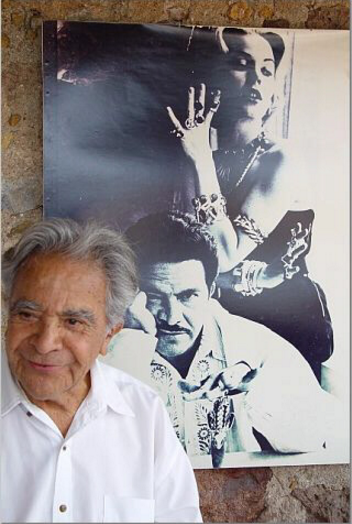Just as Tinseltown is famous for its stars, a little Mexican pueblo is world-renowned for its silver. After World War II, starlets and socialites turned their backs on war-torn Europe and headed south to Taxco… and to Antonio Pineda’s workshop, or taller. Patricia Nazario spoke with the legendary silversmith.

The Master Silversmith then and now at his studio in Taxco, Mexico in 2005. Gabrielle Stodd and Eduardo Patiño/Modern Silver Magazine
UCLA’s Fowler Museum is hosting a collection of Antonio Pineda’s work until mid-March. Director of Education and Curatorial Affairs Betsy Quick says the exhibit called Silver Seduction has a unique place in Hollywood history.
“We wanted the public to see Antonio’s work in the context of Taxco,” says Quick. “There were a dozen or so key smiths at that time, so we hope to foreground Taxco and the work of these smiths, and then open it up and then look very deeply at the taller of Antonio.”
Quick says after the Mexican Revolution in the early 1900s, artists stopped looking to Europe for inspiration and looked to the traditions of their pre-Hispanic world… then added a modern twist.
“…and this is this Modernist notion,” says Quick, “the Modern impulse that you see so beautifully expressed in the work of Antonio.”
Antonio Pineda fused traditional techniques with innovative concepts. He was one of Taxco’s first Silversmiths to design silver jewelry with precious stones. His pieces have a strong heavy look with simple lines that are almost Art Deco– and they became a high-end fashion choice in the 1940s and 50s.
“Over here,” says Pineda pointing to some of his creations, “obsidian, and some others. Jade. That one piece doesn’t look like another.”
Nazario: “As an artist, when you say that something is successful, what’s your criteria?”
Antonio Pineda: “Mágica Cósmica,” dice Pineda. “Es la alma de la artista. Lo que siente. Es la felicidad de la artista. Nunca puede tener éxitos al menos que el tenga la satisfacción, la belleza, la felicidad de éxitos de su trabajo.”
TRANSLATION:
Antonio Pineda: “Cosmic Magic,” says Pineda, “as he compares success to a romantic love affair. It’s the artist’s soul. What he feels. It’s what makes him happy. He says success lies in being satisfied with your work.”
Nazario: “Typically, how long was the time from the moment you finished drawing to the time you held the piece in your hand?”
Antonio Pineda: “Three days. Here my brother used to check exactly what I wanted. If there was something that wasn’t well done, he used to destroy it.
Bruno Pineda: “¡Pero no no no en es tres días, cómo dice!”
TRANSLATION:
Bruno Pineda: “Pero, not in three days like he says…”
Bruno is Antonio’s younger brother. He says it took more like a week or ten days. And that fast turnaround meant there were always new pieces in the store that kept Hollywood and Mexican stars coming back. Antonio Pineda remembers in a funny story about one of Mexico’s silver-screen icons, Maria Felix.

María Félix in the 1947 film Kneeling Goddess. In 1914, she was born in Sonora, Mexico and died in Mexico City, Mexico in 2002 at 88 years old.
“She was shooting a film in Taxco,” says Pineda, “at my store, I had a personal collection of jewelry inside a locked display case, things that weren’t for sale. Maria Felix fell in love with an Opal ring inside the case. The film director wanted to give it to her as a gift. I was upstairs in my studio and it took me about 5 minutes to get to them. In that time, they got impatient and with his fist… schasssshh!! The director broke the glass to get the ring!”
Pineda says, “What could I do? If I would’ve told the director the ring wasn’t for sale, he would’ve punched me, too!


